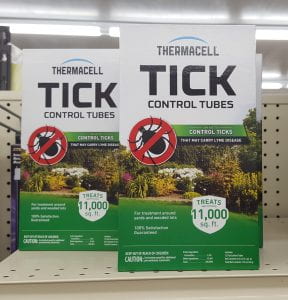“Frugality, I’ve learned, has its own cost, one that sometimes lasts forever.” –
Commercially available “tick tubes” are tubes filled with permethrin-infused cotton. Mice take the cotton to line their nests and are treated for ticks every time they return home. It’s estimated that a typical ¼ acre yard needs six tubes twice a year, with a 12 pack costing ~$45 . Although this cost isn’t excessive, there are many videos and articles on making DIY tick tubes to help people save money. But what is the actual cost?

3 Reasons Why Making Your Own Tick Tubes is a Bad Idea:
1) They probably won’t work.
A pesticide product contains inert ingredients that help the active ingredient (in this case, permethrin) perform properly for the uses listed on the product label. The formulation used in commercially available tick tubes is uniquely suited for controlling ticks on mice. Other permethrin formulations are designed for other uses which are specifically listed on the label.
2) You could be putting yourself, others, pets, nontarget animals, and the environment at unacceptable risk.

The EPA will register the use of a pesticide only if rigorous safety testing shows it will “pose no unreasonable risks to people or the environment when used according to label directions.” Only those uses listed on a pesticide label have met this standard, and making your own tick tubes is NOT a use listed on the label of any permethrin product. One potential risk: Permethrin is highly toxic to bees. Bumble bees often nest in abandoned mouse burrows, so making your own tick tubes could harm these important wild pollinators.
3) It is against the law.
Because of Reason #2, the first sentence in the Directions for Use section of all permethrin products is “It is a violation of federal law to use this product in a manner inconsistent with its labeling.” Which, by the way, also means it is against your state’s laws.
Commercially available tick tubes cost more because it takes time and money to develop the right mix of ingredients and conduct the required safety testing to ensure that the product will control ticks without putting people, pollinators, and the environment at risk. DIY tick tubes that pose greater risks while providing poorer control of ticks are hardly a bargain; be sure to use the real thing.
For information on reducing your risk of tick-borne diseases, visit www.dontgettickedny.org.

Authors:
- Dan Wixted, Cornell University Pesticide Management Education Program
- Joellen Lampman, New York State Integrated Pest Management Program